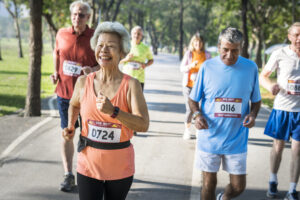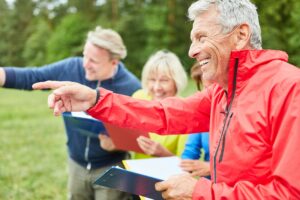As we age, our risk of falling increases (World Health Organization, 2021). Our risk of serious injury as the result of a fall also increases (World Health Organization, 2021). Falls can diminish physical function and mobility, particularly among older adults who may limit their physical activity out of pain or fear after experiencing a fall (Lord, 2001).
The good news is that people who are more physically active as they age have a decreased risk of falling (Langhammer et al., 2018). Physical activity involves any movement of the body that requires more movement than resting, from walking, housework and gardening, to running, weightlifting and other forms of sport and exercise. Physical function, on the other hand, is the capacity of an individual to perform the physical activities of daily living. Both physical activity and physical function are essential for the maintenance of our health, independence, and quality of life as we age (Langhammer et al., 2018).
 This blog outlines the importance of remaining physically active during aging to reduce the risk of falls. It also provides a description of at-home exercises that can help to prevent falls, as well as tips and resources for older adults to engage in physical activity at home and in their communities.
This blog outlines the importance of remaining physically active during aging to reduce the risk of falls. It also provides a description of at-home exercises that can help to prevent falls, as well as tips and resources for older adults to engage in physical activity at home and in their communities.
Reasons to be physically active
Physical activity has a variety of benefits for everyone, especially older adults. Regular physical activity can contribute to physical fitness and health, including the prevention cardiovascular disease, stroke, diabetes, and some types of cancer (Langhammer et al., 2018). It has also been associated with improved mental health, delayed onset of dementia and improved quality of life and wellbeing (Langhammer et al., 2018).
Falls can result in a variety of injuries ranging from minor cuts and bruises to more serious injuries such as fractured bones and joint dislocation. Physical activity can reduce the risk of falls and injury by strengthening muscles, improving posture, and improving joint range of motion (Lord, 2001). However, many people over the age of 65 do not engage in fall-reducing physical activity (McMahon et al., 2015).
Recommended activities to reduce the risk of falls
The World Health Organization recommends including both aerobic and strength exercises, along with balance exercises to reduce the risk of falls (Langhammer et al., 2018). Research shows that individuals who complete programs that include balance exercises more than 3 hours a week have a greater chance of fall prevention (Sherrington et al., 2017). Risk is further reduced when a person is physically active for 6 consecutive months (Langhammer et al., 2018).
There are two specific types of exercises that are beneficial for reducing the risk of falls in older adults: sit-to-stand exercises and balance exercises.
Sit-to-stand exercises
Completing a sequence of sit-to-stand exercises can build leg strength, which can improve stability and balance, thus reducing the risk of falling. Follow the steps below to complete a sequence of sit-to-stand exercises (Stutzman, 2021):
- Step 1: Place a standard chair in front of a sturdy surface such as a countertop or desk. Sit comfortably on the edge of the chair, with your feet flat.
- Step 2: With or without the support surface, lean forward, squeeze your legs, and push up to a standing position.
- Step 3: Slowly sit down, with or without the support surface. Repeat 10 times, twice a day.
Balance Exercises
Balances exercises help to improve postural control, stability, and coordination, which can decrease the risk of falling (Dunsky, 2019). There are a variety of ways to practice balance, depending on your level of ability and comfort. We provide 4 types of balance exercises in the list below, each exercise increasing the level of difficulty (Stutzman, 2021). While completing these exercises, stand facing a sturdy support surface in case of loss of balance. Repeat each exercise 5 times, twice a day.
- Level 1: Feet apart: stand with your feet shoulder width apart for 10 seconds, with or without support surface
- Level 2: Feet together: stand with your feet together for 10 seconds, with or without support surface
- Level 3: One foot: stand on one foot for 10 seconds, with or without support surface
- Level 4: Eyes closes: if above exercises can be completed properly, complete with eyes closed
Where to access physical activity
 Many exercises to reduce the risk of falls can be completed at home. However, there are many exercise classes geared towards older adults that are often offered within the community at recreation facilities. Be sure to check in with your local community centre to ask about exercise programs for older adult.
Many exercises to reduce the risk of falls can be completed at home. However, there are many exercise classes geared towards older adults that are often offered within the community at recreation facilities. Be sure to check in with your local community centre to ask about exercise programs for older adult.
Resources for activity programming
Listed below are available resources for older adults:
- YMCA 55 Plus Programs
- Participaction Physical Activity Toolkit
- Active Aging Canada
- Active at Home videos from the Canadian Centre for Activity and Aging
- CBC article on online workouts for seniors
Final thoughts
Maintaining exercise levels and walking frequently are the best route to successful aging and the primary prevention of immobility, falls and injuries (Judge, 2017). No matter what age or what fitness level you are, there are many ways to participate in physical activity, whether it be aerobic exercise, strength training, balance exercises or walking.